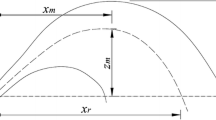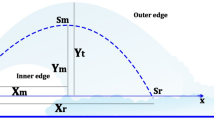Abstract
Dispersion of turbulent jets in shallow coastal waters has numerous engineering applications. The accurate forecasting of the complex interaction of these jets with the ambient fluid presents significant challenge and has yet to be fully elucidated. In this paper, numerical simulation of \(30{^\circ }\) and \(45{^\circ }\) inclined dense turbulent jets in stationary water have been conducted. These two angles are examined in this study due to lower terminal rise heights for \(30{^\circ }\) and \(45{^\circ }\), this is critically important for discharges of effluent in shallow waters compared to higher angles. Mixing behavior of dense jets is studied using a finite volume model (OpenFOAM). Five Reynolds-Averaged Navier–Stokes turbulence models are applied to evaluate the accuracy of CFD predictions. These models include two Linear Eddy Viscosity Models: RNG \( k-\varepsilon \), and realizable \(k-\varepsilon \); one Nonlinear Eddy Viscosity Model: nonlinear \(k-\varepsilon \); and two Reynolds Stress Models: LRR and Launder–Gibson. Based on the numerical results, the geometrical characteristics of the dense jets, such as the terminal rise height, the location of centerline peak, and the return point are investigated. The mixing and dilution characteristics have also been studied through the analysis of cross-sectional concentration and velocity profiles. The results of this study are compared to various advanced experimental and analytical investigations, and comparative figures and tables are discussed. It has been observed that the LRR turbulence model as well as the realizable \(k-\varepsilon \) model predicts the flow more accurately among the various turbulence models studied herein.










Similar content being viewed by others
References
Global Water Intelligence editorial team (2004) Desalination markets: 2005–2015. Media Analytics Ltd, Oxford
Sajwani AA (1998) The desalination plants of Oman: past, present, and future. Desalination 120:53–59
Einav R, Lokiec F (2003) Environmental aspects of a desalination plant in Ashkelon. Desalination 156:79–85
Hashim A, Hajjaj M (2005) Impact of desalination plants fluid effluents on the integrity of seawater, with the Arabian Gulf in perspective. Desalination 182:373–393
Lattemann S, Hoepner T (2008) Environmental impact and impact assessment of seawater desalination. Desalination 220:1–15
Fischer HB, List EJ, Koh RCY, Imberger J, Brooks NH (1979) Mixing in inland and coastal waters. Academic Press, New York
Zeitoun MA, McHilhenny WF, Reid RO (1970) Conceptual designs of outfall systems for desalination plants. Research and development progress report no. 550. Technical report, Office of Saline Water. United States Department of the interior
Roberts PJW, Toms G (1987) Inclined dense jets in flowing current. J Hydraul Eng ASCE 113(3):323–341
Pincince AB, List EJ (1973) Disposal of brine into an estuary. J Water Pollut Control Fed 45(11):2335–2344
Roberts PJW, Ferrier A, Daviero G (1997) Mixing in inclined dense jets. J Hydraul Eng ASCE 123(8):693–699
Cipolina A, Brucato A, Grisafi F et al (2005) Bench-scale investigation of inclined dense jets. J Hydraul Eng ASCE 131(11):1017–1022
Kikkert GA, Davidson MJ, Nokes RI (2007) Inclined negatively buoyant discharge. J Hydraul Eng ASCE 133(5):545–554
Jirka GH (2004) Integral model for turbulent buoyant jets in unbounded stratified flows. Part I: the single round jet. Environ Fluid Mech 4:1–56
Jirka GH (2008) Improved discharge configurations for brine effluents from desalination plants. J Hydraul Eng ASCE 134(1):116–120
Shao D, Law AWK (2010) Mixing and boundary interactions of 30 and 45 inclined dense jets. Environ Fluid Mech 10:521–553
Papakostantis IG, Christodoulou GC, Papanicolaou PN (2011) Inclined negatively buoyant jets I: geometrical characteristics. J Hydraul Res 49(1):3–12
Papakostantis IG, Christodoulou GC, Papanicolaou PN (2011) Inclined negatively buoyant jets II: concentration measurements. J Hydraul Res 49(1):13–22
Lai CCK, Lee JHW (2012) Mixing of inclined dense jets in stationary ambient. J Hydro-environ Res 6:9–28
Lee JHW, Chu VH (2003) Turbulent jets and plumes: a lagrangian approach. Academic Publishers, Leiden
Vafeiadou P, Papakonstantis I, Christodoulou G (2005) Numerical simulation of inclined negatively buoyant jets, The 9th international conference on environmental science and technology, September 1–3, Rhodes island, Greece
Kim DG, Cho HY (2006) Modeling the buoyant flow of heated water discharged from surface and submerged side outfalls in shallow and keep water with a cross flow. J Environ Fluid Mech 6:501–518
Oliver CJ, Davidson MJ, Nokes RI (2008) k-\(\varepsilon \) prediction of the initial mixing of desalination discharges. J Environ Fluid Mech 8:617–625
Kheirkhah Gildeh H, Mohammadian A, Nistor I, Qiblawey H (2014) Numerical modeling of turbulent buoyant wall jets in stationary ambient water. J Hydraul Eng ASCE 140(6):04014012
OpenCFD Limited (2012) OpenFOAM - Programmer’s Guide, Version 2.1.1
OpenCFD Limited (2012) OpenFOAM - User Guide. Version 2.1.1
Bauer W, Haag O, Hennecke DK (2000) Accuracy and robustness of nonlinear eddy viscosity models. J Heat Fluid Flow 21:312–319
Shih TH, Zhu J, Lumley JL (1995) A new Reynolds stress algebraic equation model. Comput Methods Appl Mech Eng 125:287–302
Speziale CG (1991) Analytical methods for the development of Reynolds-stress closures in turbulence. Annu Rev Fluid Mech 23:107–157
Gibson MM, Launder BE (1978) Ground effects on pressure fluctuations in the atmospheric boundary layer. J Fluid Mech 86:491–511
Launder BE, Reece GJ, Rodi W (1975) Progress in the development of a Reynolds-stress turbulence closure. J Fluid Mech 68(3):537–566
Millero FJ, Poisson A (1981) International one-atmosphere equation of state of sea water. J Deep-Sea Res 28A(6):625–629
Huai W, Li Z, Qian Z et al (2010) Numerical simulation of horizontal buoyant wall jet. J Hydrody 22(1):58–65
Ferziger JH, Peric M (2002) Computational methods for fluid dynamics, 3rd edn. Springer-Verlag, Berlin Heidelberg New York
Issa RI (1985) Solution of the implicitly discretized fluid flow equations by operator-splitting. J Comput Phys 62:40–65
Issa RI, Gosman AD, Watkins AP (1986) The computation of compressible and incompressible recirculating flow by a non-iterative implicit scheme. J Comput Phys 62:66–82
Oliveira PJ, Issa RI (2001) An improved PISO algorithm for the computation of buoyancy-driven flows. Num Heat Transf 40:473–493
Shao D (2009) Desalination discharge in shallow coastal waters. PhD thesis, Nanyang Technological University, Singapore
Ferrari S, Querzoli G (2004) Sea discharge of brine from desalination plants: a laboratory model of negatively buoyant jets. In: MWWD 2004-The 3rd international conference on marine waste water disposal and marine environment, September 17–October 2, Catania, Italy
Hanjalic K (1994) Advanced turbulence closure models: a view of current status and future prospects. Int J Heat Fluid Flow 15(3):178–203
Papakonstantis IG, Christodoulou GC, Papanicolaou PN (2011) Inclined negatively buoyant jets 1: geometrical characteristics. J Hydraul Res 49(1):3–12
Papakonstantis IG, Christodoulou GC, Papanicolaou PN (2011) Inclined negatively buoyant jets 2: concentration measurements. J Hydraul Res 49(1):13–22
Madni IK, Ahmed SZ (1989) Prediction of turbulent, axisymmetric, dense jets discharged to quiescent ambients. Math Comput Model 12(3):363–370
Bloomfield LJ, Kerr RC (2002) Inclined turbulent fountains. J Fluid Mech 451:283–294
Nemlioglu S, Roberts PJW (2006) Experiments on dense jets using three-dimensional laser-induced fluorescence (3DLIF) MWWD 2006-The 4th international conference on marine waste water disposal and marine environment, November 6–10, Antalya, Turkey
Chu PCK, Lee JHW, Chu VH (1999) Spreading of a turbulent round jet in coflow. J Hydraul Eng ASCE 125(2):193–204
Kikkert GA (2006) Buoyant jets with two and three-dimensional trajectories. PhD thesis, University of Canterbury, New Zealand
Chen CJ, Rodi W (1980) Vertical turbulent buoyant jets: a review of experimental data. NASA STI/Recon Technical Report A 80
Bradshaw P (1987) Turbulent secondary flow. Annu Rev Fluid Mech 19:53–74
Ungate CD, Harleman DRF, Jirka GH (1975) Stability and mixing of submerged turbulent jets at low Reynolds numbers. Energy Laboratory Report MIT-EL 75–014
Pearce AF (1966) Critical Reynolds number for fully-developed turbulence in circular submerged water jets. Council for Scientific and Industrial Research, Report MEG 475
Sobey RJ, Johnston AJ, Keane RD (1988) Horizontal round buoyant jet in shallow water. J Hydraul Eng ASCE 114(8):910–929
Acknowledgments
This publication was made possible by NPRP grant #4-935-2-354 from the Qatar National Research Fund (a member of Qatar Foundation). The statements made herein are solely the responsibility of the authors. The authors are also grateful to the anonymous reviewers for their helpful comments.
Author information
Authors and Affiliations
Corresponding author
Rights and permissions
About this article
Cite this article
Kheirkhah Gildeh, H., Mohammadian, A., Nistor, I. et al. Numerical modeling of \(30^{\circ }\) and \(45{^\circ }\) inclined dense turbulent jets in stationary ambient. Environ Fluid Mech 15, 537–562 (2015). https://doi.org/10.1007/s10652-014-9372-1
Received:
Accepted:
Published:
Issue Date:
DOI: https://doi.org/10.1007/s10652-014-9372-1




